Table of Contents
- Introduction
- Editor’s Choice
- Teenage Smokers Prevalence Statistics
- Countries with the Highest Share of Current Smokers Among Young Teens
- Demographic Insights
- Teenage Smokers in North America Statistics
- Teenage Smokers in Asia Pacific Statistics
- Teenage Smokers in Europe Statistics
- Teenage Smokers Frequency Statistics
- Usual Smoking Locations for High School Students
- Acceptance of Teenage Smokers Statistics
- Treatments and Remedies Utilized
- Initiatives to Combat Teenage Smoking
- Government Regulations for Teenage Smoking
- Recent Developments
- Conclusion
- FAQs
Introduction
Teenage Smokers Statistics: Teenage smoking poses a significant public health challenge, with many adult smokers having started in their adolescent years.
Health implications are profound, including immediate respiratory issues and long-term risks such as chronic obstructive pulmonary disease and cardiovascular problems.
Social factors like peer pressure, family influence, and media exposure contribute to smoking initiation among teenagers.
Effective prevention and intervention strategies include education programs, regulatory measures, and support services.
Governments often enact policies such as age restrictions and advertising bans to curb smoking rates while research continues to explore contributing factors and assess intervention effectiveness.
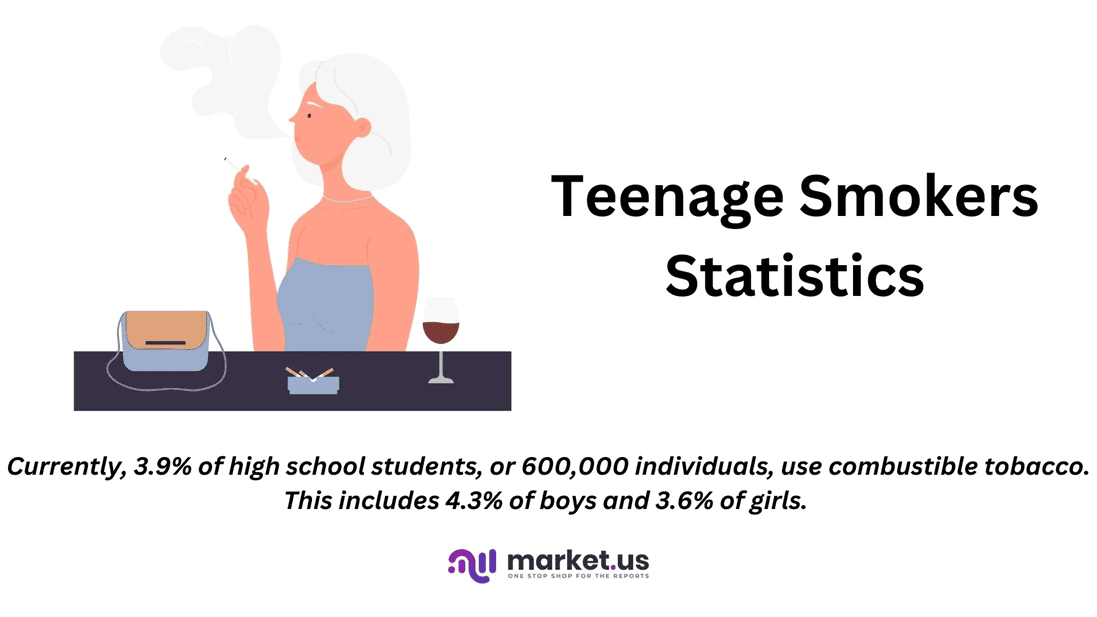
Editor’s Choice
- In 2019, the prevalence of cigarette smoking among teens aged 13 to 15 showcased significant global variation. Palau and Bulgaria reported the highest prevalence, with figures reaching 32.50% and 32% respectively.
- The data provided showcases the prevalence of cigarette smoking among teens aged 13 to 15 across various countries as of 2019, differentiated by gender. Notably, Timor-Leste records the highest prevalence among males at 39.40%, contrasted with a significantly lower rate among females at 6.40%.
- As of fall 2023, a survey conducted among college students in the U.S. revealed their usage of various tobacco products within the last three months. The most frequently used product was e-cigarettes or other vape products, with 75.3% of respondents reporting usage.
- The 2019 data concerning cigarette usage among students aged 16 across various European countries reveals significant variability in both 30-day and lifetime usage rates. Slovakia leads with a 30-day usage rate of 29% and a lifetime usage rate of 58%.
- As of 2019, high school students in India reported various usual smoking locations, with the highest share of respondents (23.5%) indicating that they smoked at home.
- Initiatives such as the Truth Initiative’s youth-focused campaigns have effectively raised awareness about the dangers of nicotine addiction, contributing to declines in vaping rates from 27.3% to 23.2% among 12th graders in 2023.
- In the U.S., the FDA enforces strict laws, including a minimum purchase age of 21 for tobacco products, along with penalties for retailers that sell to minors and educational campaigns like “The Real Cost” to inform youth about the dangers of smoking.
Teenage Smokers Prevalence Statistics
Number of Smokers Worldwide
- The global number of tobacco smokers has shown fluctuations from 2014 to 2029.
- In 2014, the number of smokers worldwide stood at 1,079.14 million, slightly decreasing to 1,075.99 million in 2015.
- This downward trend continued through 2016 and 2017, where the figures reached 1,072.38 million and 1,072.22 million, respectively.
- From 2018 onwards, the number remained relatively stable, with minor increases, reaching 1,072.51 million in 2019 and 1,073.19 million in 2020.
- By 2021, the number of smokers had risen to 1,074.13 million, continuing to grow in subsequent years, reaching 1,075.27 million in 2022 and 1,076.74 million in 2023.
- This upward trend persisted, with projections for 2024 indicating 1,078.66 million smokers and further growth, reaching 1,081.01 million by 2025.
- By 2026, the figure is expected to rise to 1,083.50 million, continuing its increase to 1,086.29 million in 2027, 1,089.34 million in 2028, and 1,092.59 million by 2029.
- Overall, the data indicates a modest but consistent rise in the global number of smokers from 2021 onwards.
(Source: Statista)

Prevalence of Smoking Worldwide
- The prevalence of smoking worldwide has been consistently declining from 2001 to 2029.
- In 2001, the population share of smokers stood at 33.49%, gradually decreasing to 32.78% in 2002 and 32.1% in 2003.
- This downward trend continued through the decade, with the smoking population dropping to 30.78% in 2005, 29.52% in 2007, and 28.32% by 2009.
- By 2010, the prevalence had decreased further to 27.75%, reaching 25.67% in 2014 and 24.71% by 2016.
- The decline continued, with the smoking population share dropping to 23.35% in 2019 and 22.91% in both 2020 and 2021.
- The trend is projected to persist in the coming years, with the population share expected to reduce to 22.01% by 2024, 21.4% in 2026, and eventually 20.53% by 2029.
- This data indicates a continuous reduction in the global smoking prevalence over nearly three decades, reflecting the effectiveness of anti-smoking campaigns and policies implemented worldwide.
(Source: Statista)
Take advantage of our unbeatable offer - buy now!

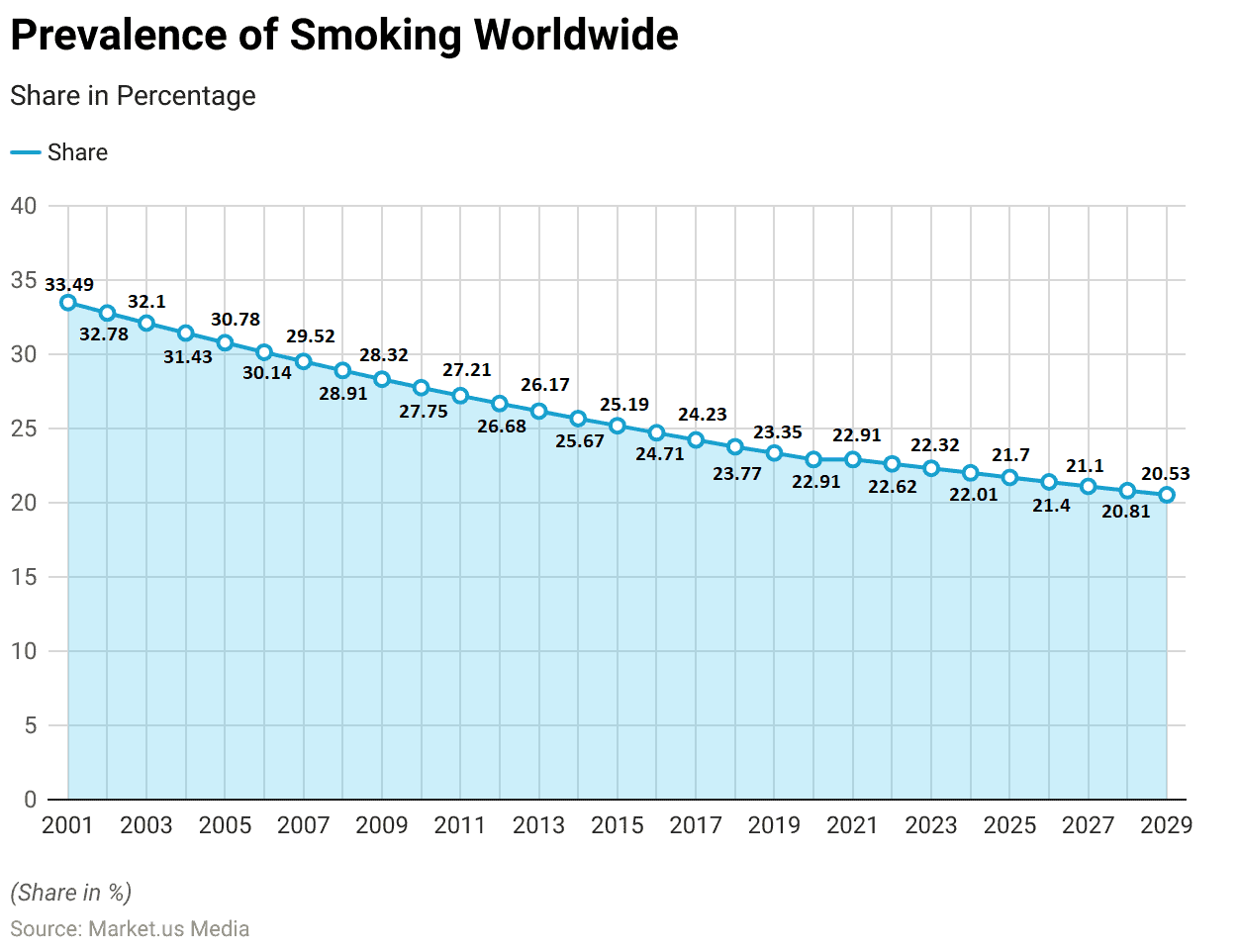
Percentage of Tobacco Smokers Worldwide – By Region
- The global prevalence of tobacco smoking among individuals aged 15 years and older has experienced a steady decline from 2000 to 2025.
- In 2000, the overall smoking prevalence was 26.9%, which decreased to 23.7% in 2005, 21.1% in 2010, 18.9% in 2015, 17% in 2020, and is projected to reach 15.4% by 2025.
- Regionally, the African region showed a significant reduction, from 14.5% in 2000 to a projected 7.4% in 2025.
- The Americas saw a decline from 26.1% in 2000 to 13.2% by 2025.
- In Southeast Asia, the prevalence decreased from 29.3% in 2000 to an estimated 11.4% by 2025.
- Europe, which had the highest smoking rate at 34% in 2000, is projected to reduce to 23.2% by 2025.
- The Eastern Mediterranean region also witnessed a decline from 20.3% in 2000 to a forecasted 13.5% in 2025.
- Meanwhile, the Western Pacific region’s smoking prevalence decreased from 27.7% in 2000 to an expected 21.9% by 2025.
- This global trend reflects a significant reduction in smoking prevalence across all regions over the 25 years.
(Source: Statista)
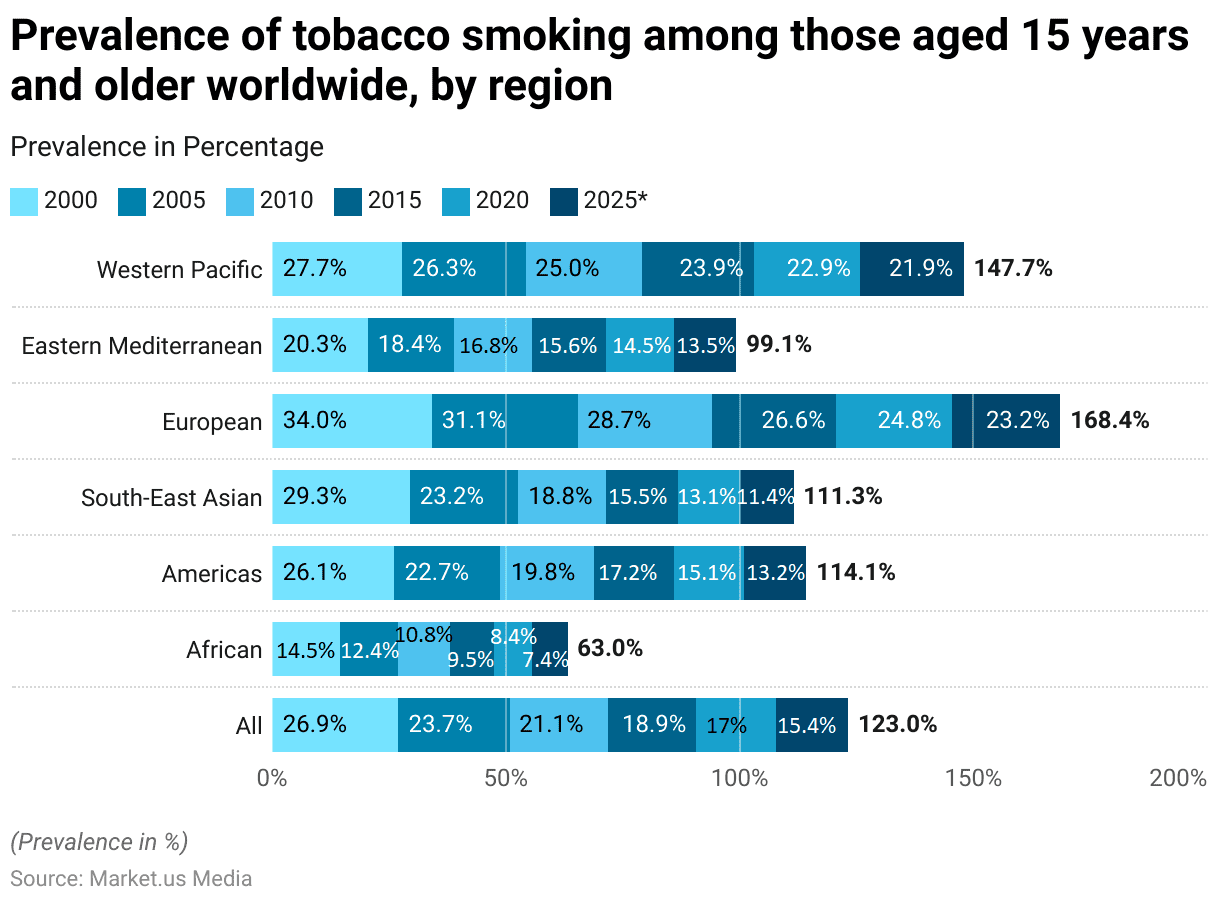
Number of Tobacco Smokers Worldwide – By Region
- The global number of tobacco smokers aged 15 years and older has fluctuated across various regions from 2000 to 2030.
- In the African region, the number of smokers increased from 59 million in 2000 to 64 million by 2030, demonstrating a steady rise.
- In contrast, the Americas saw a decline from 159 million smokers in 2000 to a projected 121 million by 2030.
- The Southeast Asian region, which had the highest number of smokers at 488 million in 2000, is expected to decrease to 387 million by 2030.
- In Europe, the number of smokers fell from 229 million in 2000 to a projected 164 million by 2030.
- The Eastern Mediterranean region showed an increase from 74 million smokers in 2000 to an estimated 103 million by 2030.
- Meanwhile, in the Western Pacific region, the number of smokers peaked at 374 million in 2015 before declining to a projected 357 million by 2030.
- This data highlights varying trends in smoking prevalence across different regions, with most areas seeing a decline in smokers, except for the African and Eastern Mediterranean regions, where the numbers are rising.
(Source: Statista)
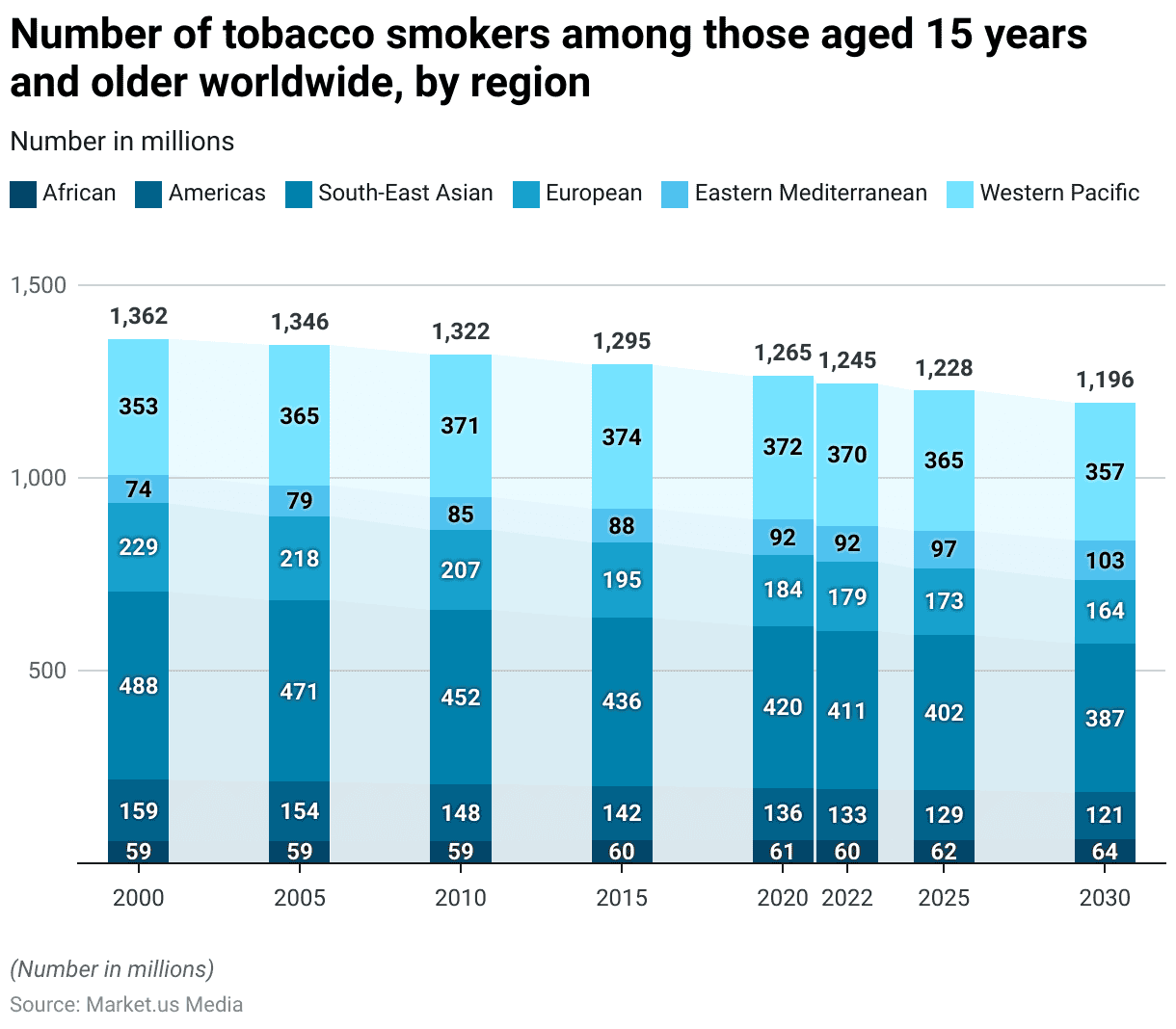
- In 2019, the prevalence of cigarette smoking among teens aged 13 to 15 showcased significant global variation.
- Palau and Bulgaria reported the highest prevalence, with figures reaching 32.50% and 32% respectively.
- Romania followed closely with a prevalence of 31%.
- Both Croatia and Slovakia showed a smoking rate of 29% among teens, while Austria reported a 25% prevalence.
- Czechia and Chile also displayed considerable percentages at 23.60% and 23.30% respectively.
- Other notable statistics include Kiribati at 22.80% and both Poland and Ukraine at 22%.
- Lithuania’s prevalence was 21%, and Papua New Guinea, Micronesia, and Timor-Leste reported rates slightly above 20%.
- Estonia, Monaco, and North Macedonia each recorded a prevalence of 20%, while Indonesia and Slovenia were at 19.20% and 19% respectively.
- This data highlights substantial disparities in teenage smoking rates across different countries.
(Source: Statista)

Demographic Insights
By Gender
- The data provided showcases the prevalence of cigarette smoking among teens aged 13 to 15 across various countries as of 2019, differentiated by gender.
- Notably, Timor-Leste records the highest prevalence among males at 39.40%, contrasted with a significantly lower rate among females at 6.40%.
- Palau follows closely, with rates of 38.40% for males and 26.80% for females.
- In Indonesia, the prevalence among males stands at 38.30%, with a minimal 2.40% among females.
- Other countries with notable disparities include Kiribati (32.20% for males and 14.70% for females) and Romania, where the rates are more balanced at 32.00% for females and 30.00% for males.
- Bulgaria and Slovakia show high prevalence rates among females at 36.00% and 33.00%, respectively, with males at 27.00% and 26.00%.
- Lower down the list, countries like Austria, Kuwait, and Malaysia exhibit more moderate smoking rates among both genders, with Austria reporting 26.00% for females and 24.00% for males, Kuwait with 8.30% for females and 23.20% for males, and Malaysia at 5.30% for females and 22.40% for males.
- This data underscores significant variations in teenage smoking habits across different countries and between genders.
(Source: Statista)
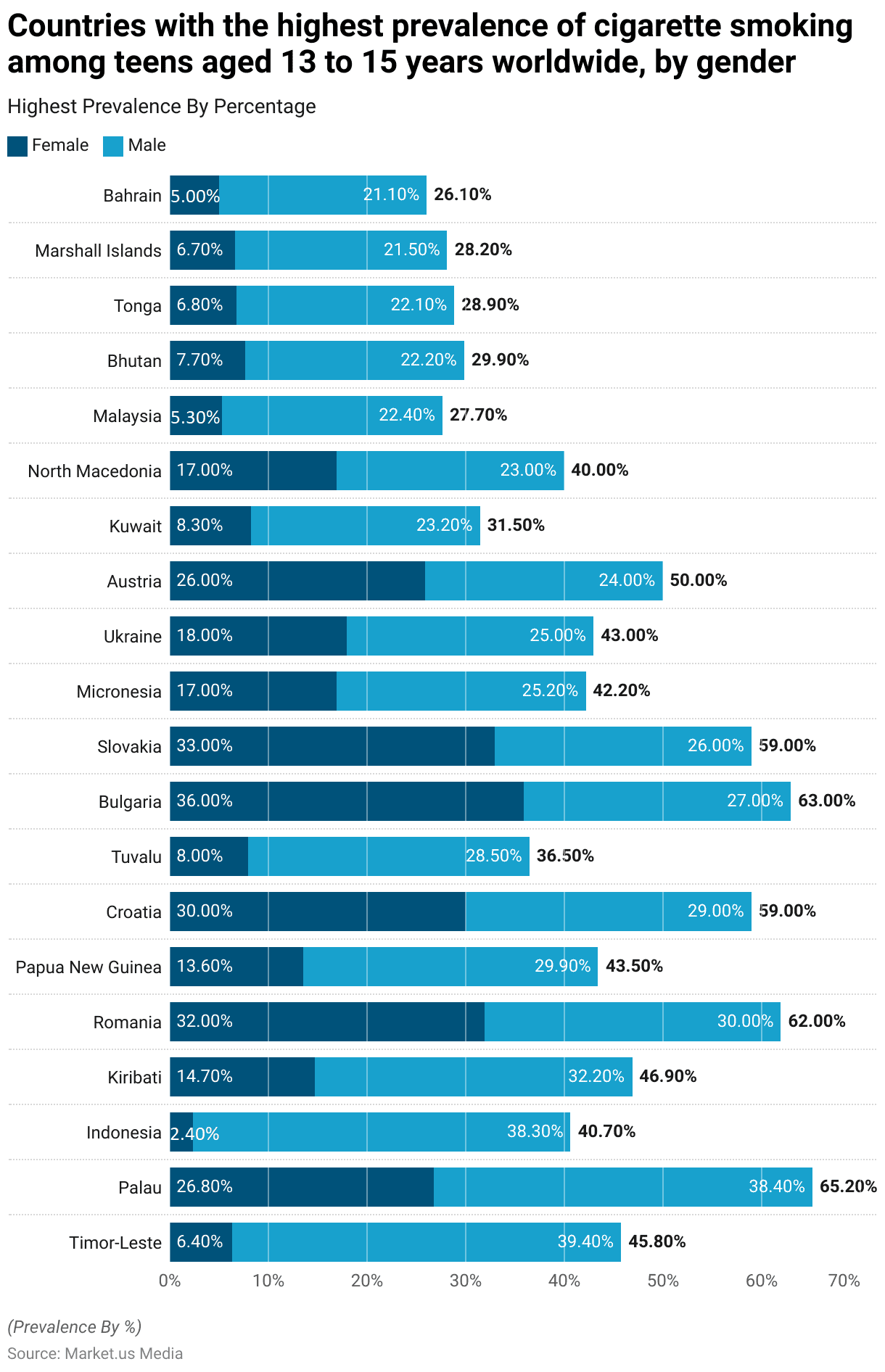
By Race/Ethnicity
- The data reveals the usage of various tobacco products among high school students in the U.S. in 2023, categorized by race/ethnicity.
- Among White, non-Hispanic students, 11.30% reported using electronic cigarettes, 1.40% smoked cigars, 2.20% used cigarettes, 1.70% engaged in smokeless tobacco use, 0.60% used pipe tobacco, and 13.60% used any tobacco product.
- For Black, non-Hispanic students, the usage rates were 5.60% for electronic cigarettes, 1.90% for cigars, and 9.80% for any tobacco products.
- Hispanic students reported 9.70% usage for electronic cigarettes, 2.30% for cigars, 2.20% for cigarettes, 1.70% for smokeless tobacco, and 1.00% for hookah, with 12.40% using any tobacco products.
- Notably, the data shows higher usage of electronic cigarettes among White and Hispanic students compared to their Black counterparts and a varied distribution in the use of other tobacco products across these ethnicities.
(Source: Statista)
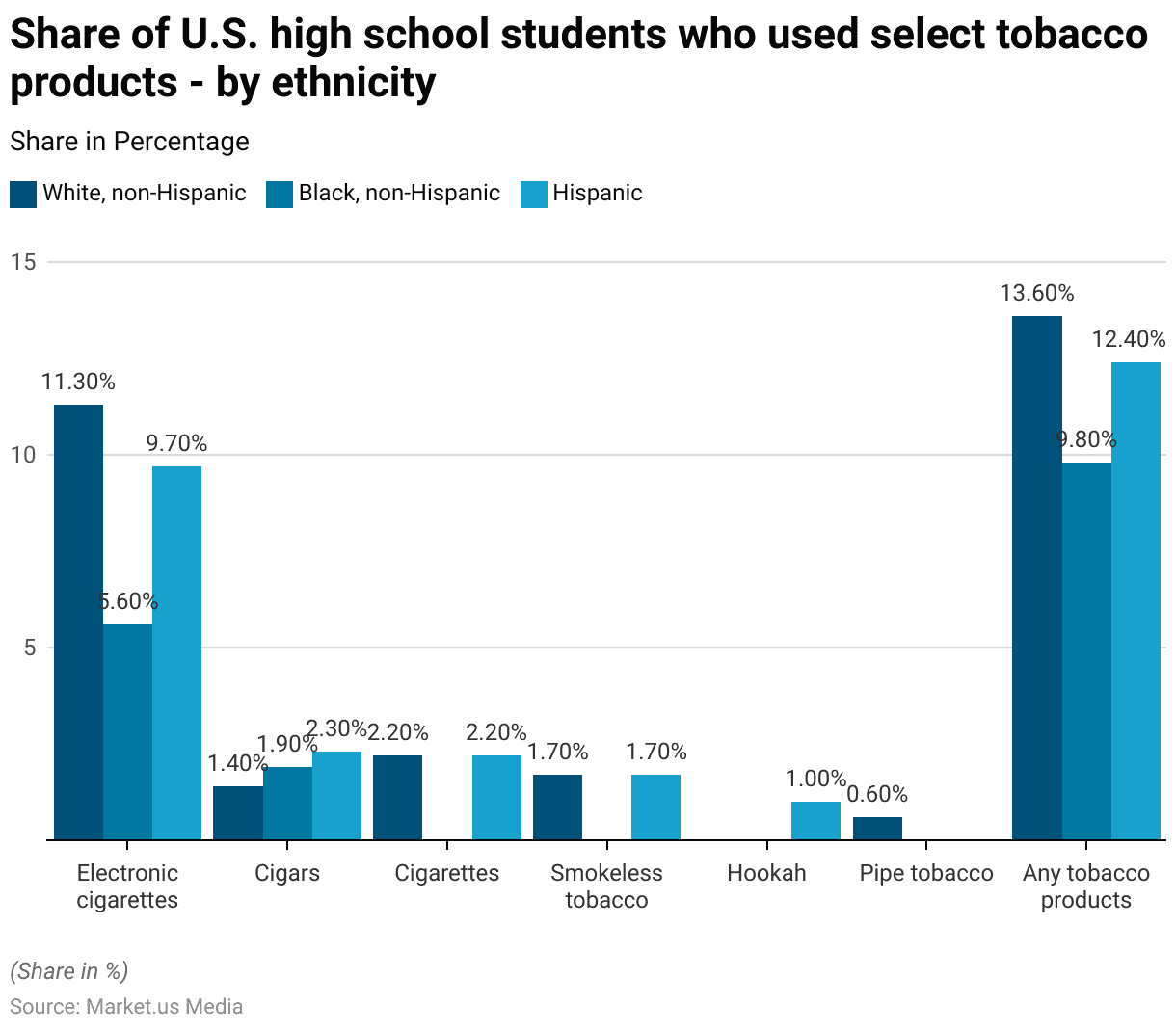
By Income Group
- The prevalence of tobacco smoking among individuals aged 15 years and older globally has been tracked across various income groups from 2000 to 2025.
- Overall, there has been a consistent decline in smoking rates across all income groups over the 25 years.
- In 2000, the prevalence of smoking among all income groups was 26.90%, which gradually decreased to an estimated 17.30% by 2025.
- Specifically, high-income countries showed a starting prevalence of 33.60% in 2000, reducing to 20.50% by 2025.
- Upper-middle-income countries reported a decrease from 29.60% in 2000 to 20.40% in 2025.
- Lower-middle-income countries saw a decline from 23.10% to 15.50% over the same period, and low-income countries recorded a decrease from 16.10% to 9.80%.
- This trend illustrates a global shift towards lower smoking rates across different economic strata over the quarter-century.
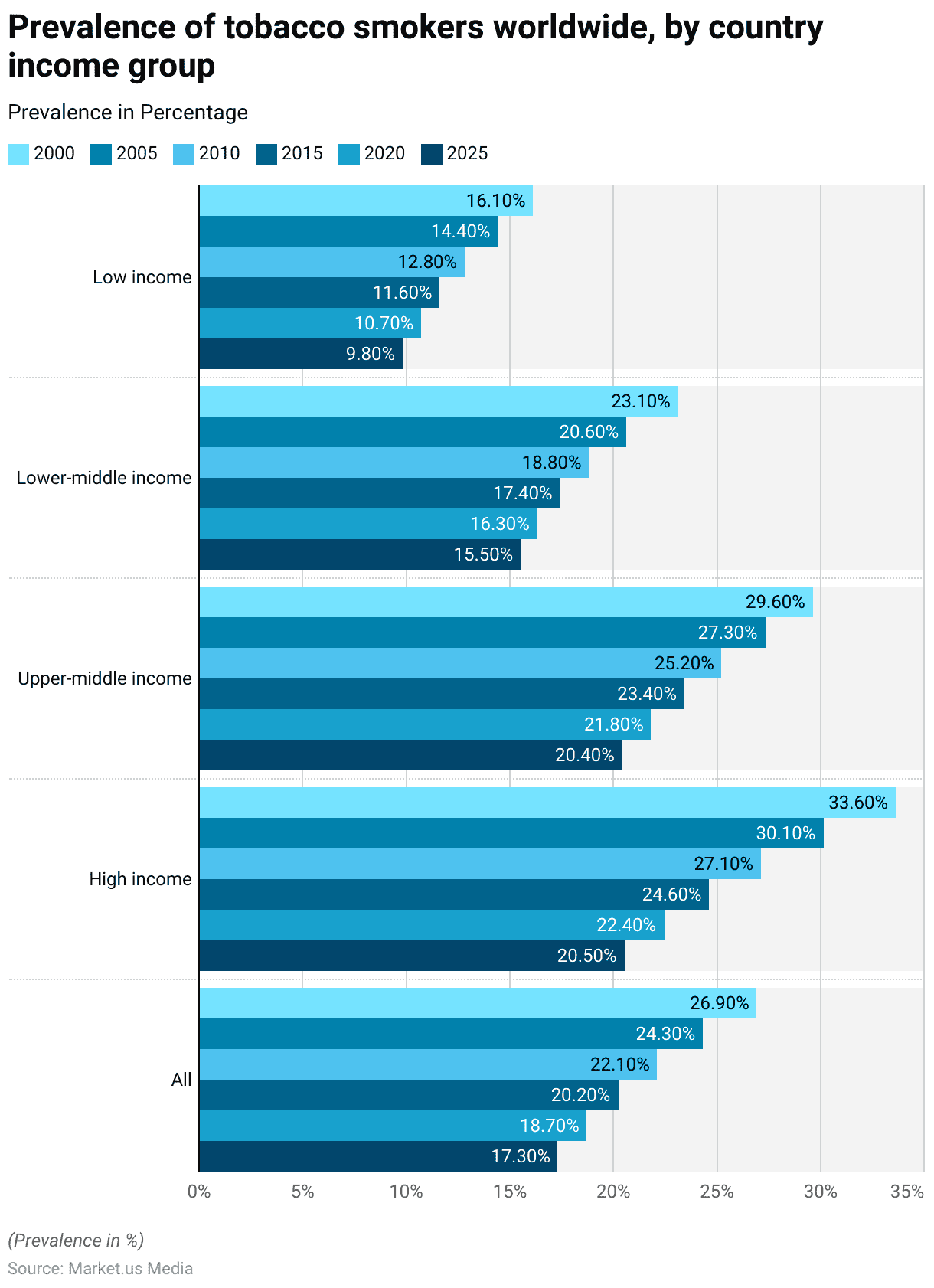
Teenage Smokers in North America Statistics
United States
- As of fall 2023, a survey conducted among college students in the U.S. revealed their usage of various tobacco products within the last three months.
- The most frequently used product was e-cigarettes or other vape products, with 75.3% of respondents reporting usage.
- Cigarettes followed, with 44% of the students indicating they had smoked in this period.
- A smaller percentage, 14%, reported using cigars or little cigars, while 9.2% had used chewing or smokeless tobacco.
- Water pipes or hookahs were used by 7.5% of the respondents, and 5% reported using other tobacco products.
(Source: Statista)

Canada
- In the 2016/17 period, the share of students in grades 7-9 in Canada who had tried smoking varied significantly by province.
- The national average for students who had experimented with smoking was 8.6%.
- Saskatchewan reported the highest percentage, with 16.4% of students having tried smoking.
- Quebec followed with 14.9%, while Nova Scotia saw 13% of its students trying smoking.
- In Newfoundland and Labrador, the percentage was 12.1%, and Manitoba had 11.4% of students who had tried smoking.
- Prince Edward Island recorded a 10.8% rate, and Alberta was slightly below the national average at 8.5%.
- British Columbia and Ontario reported the lowest percentages, with 5.8% and 4.7%, respectively.
(Source: Statista)
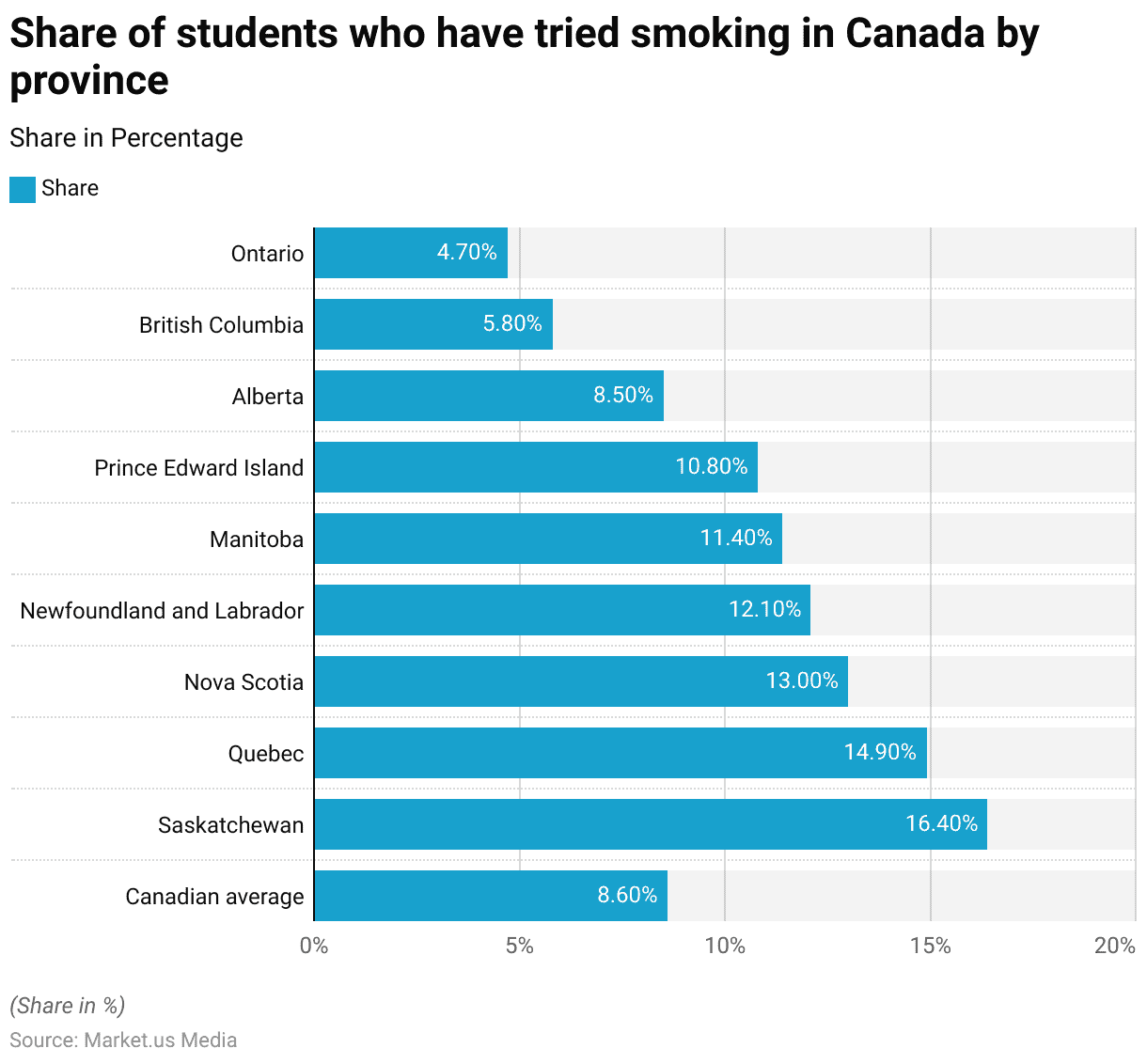
Mexico
- The annual prevalence of tobacco use among teenagers in Mexico showed a notable decline between 2011 and 2016, with significant differences between genders.
- In 2011, 8.1% of girls reported using tobacco, while by 2016, this percentage had decreased to 5.5%.
- For boys, tobacco use was higher, with 16.4% reporting usage in 2011, dropping to 10% in 2016.
- On average, the total teenage population saw a decline in tobacco use from 12.3% in 2011 to 7.8% in 2016, reflecting an overall reduction in smoking habits among Mexican teens over the five years.
(Source: Statista)
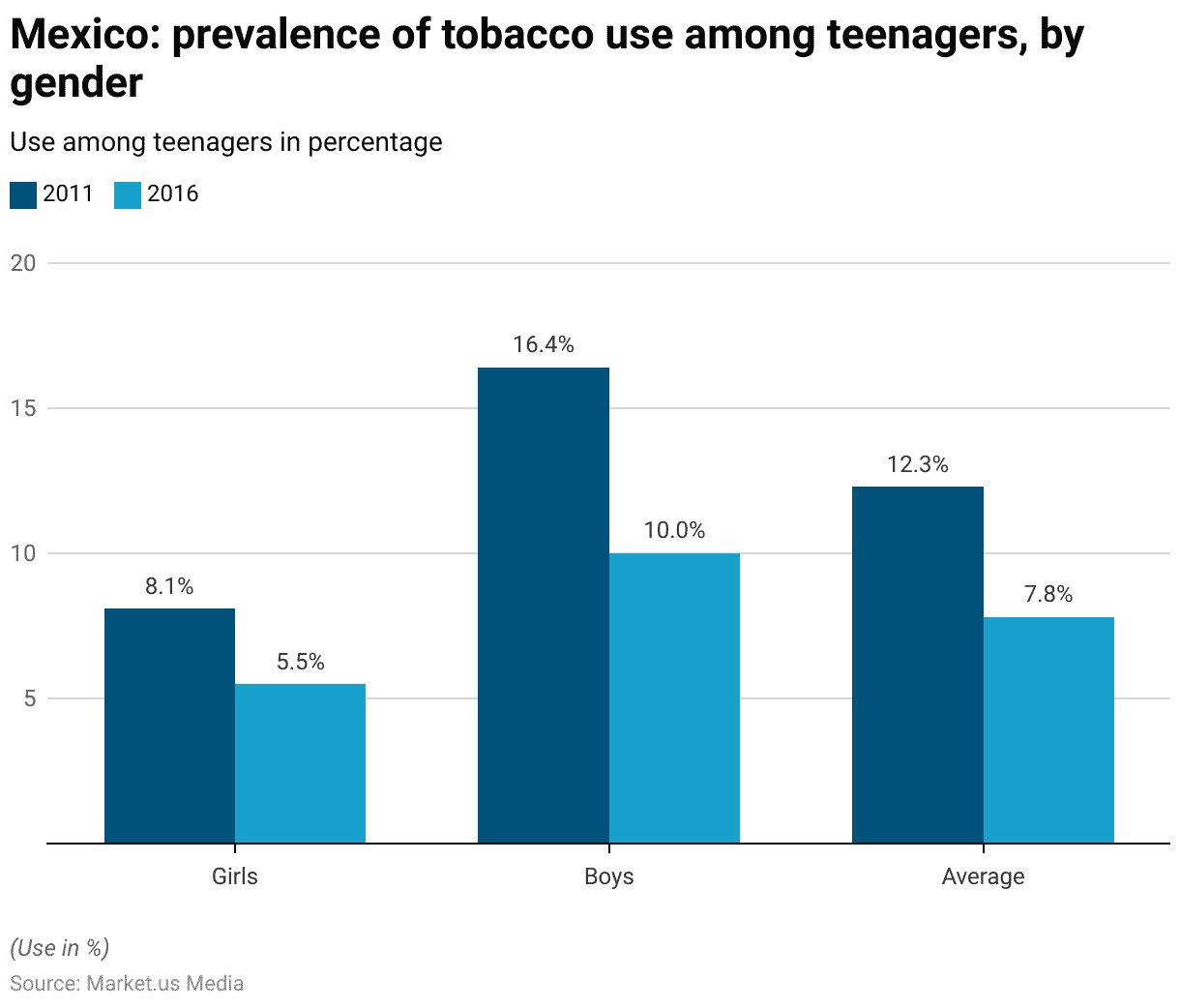
Teenage Smokers in Asia Pacific Statistics
China
- In 2021, the smoking rate among high school students in China showed a significant gender disparity.
- Among male students, 7.1% were reported as smokers, while the smoking rate among female students was much lower, at 1.9%.
- Overall, the total share of smokers among high school students in the country stood at 4.9%, indicating that tobacco use was more prevalent among males compared to females.
(Source: Statista)
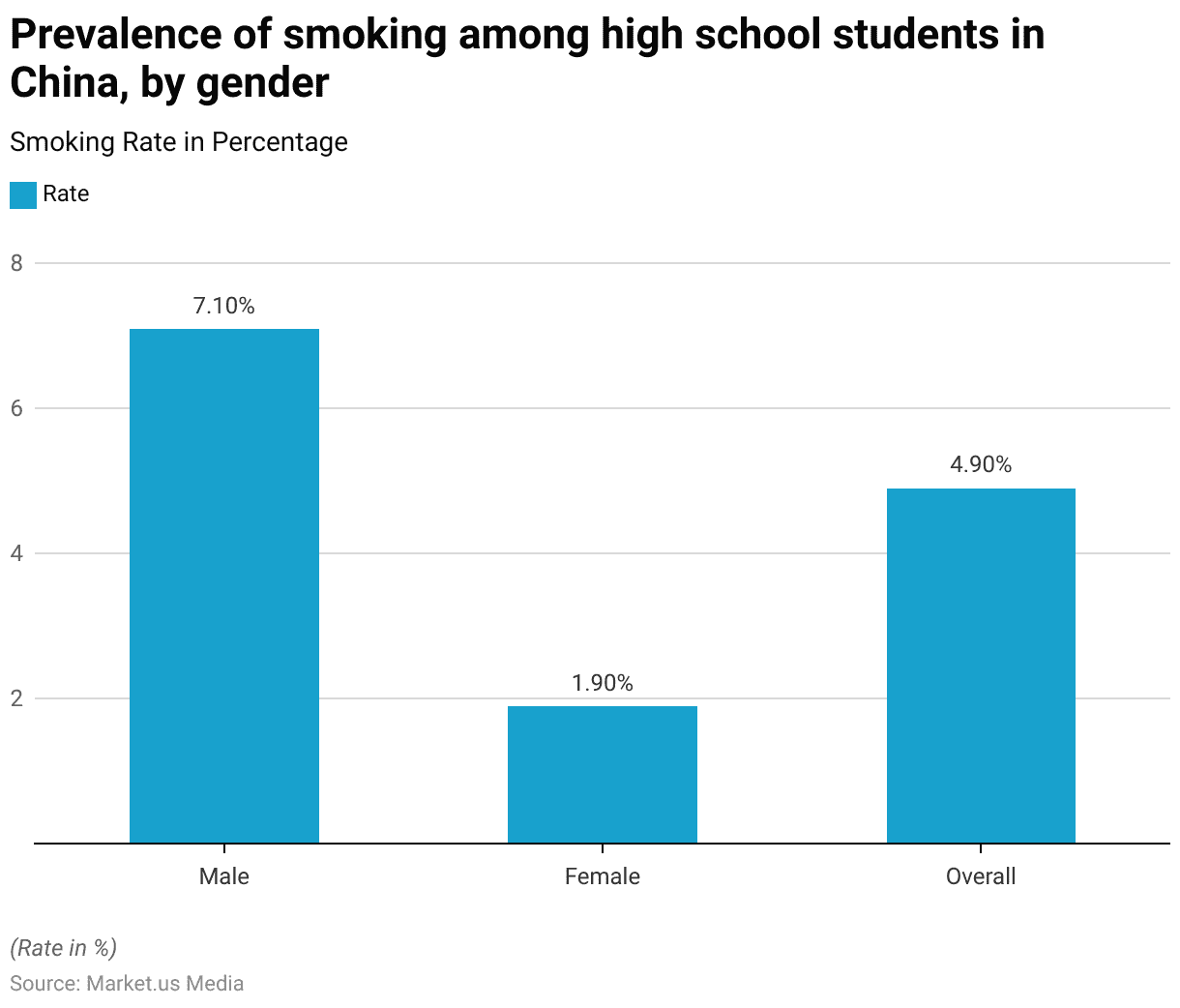
India
- The share of tobacco users among high school students in India has seen a notable decline between 2003 and 2019.
- In 2003, 16.9% of students reported using tobacco.
- This percentage decreased to 13.7% in 2006 before rising slightly to 14.6% in 2009.
- However, by 2019, the share of tobacco users had dropped significantly to 8.5%, indicating a positive trend in reducing tobacco use among high school students over the 16 years.
(Source: Statista)
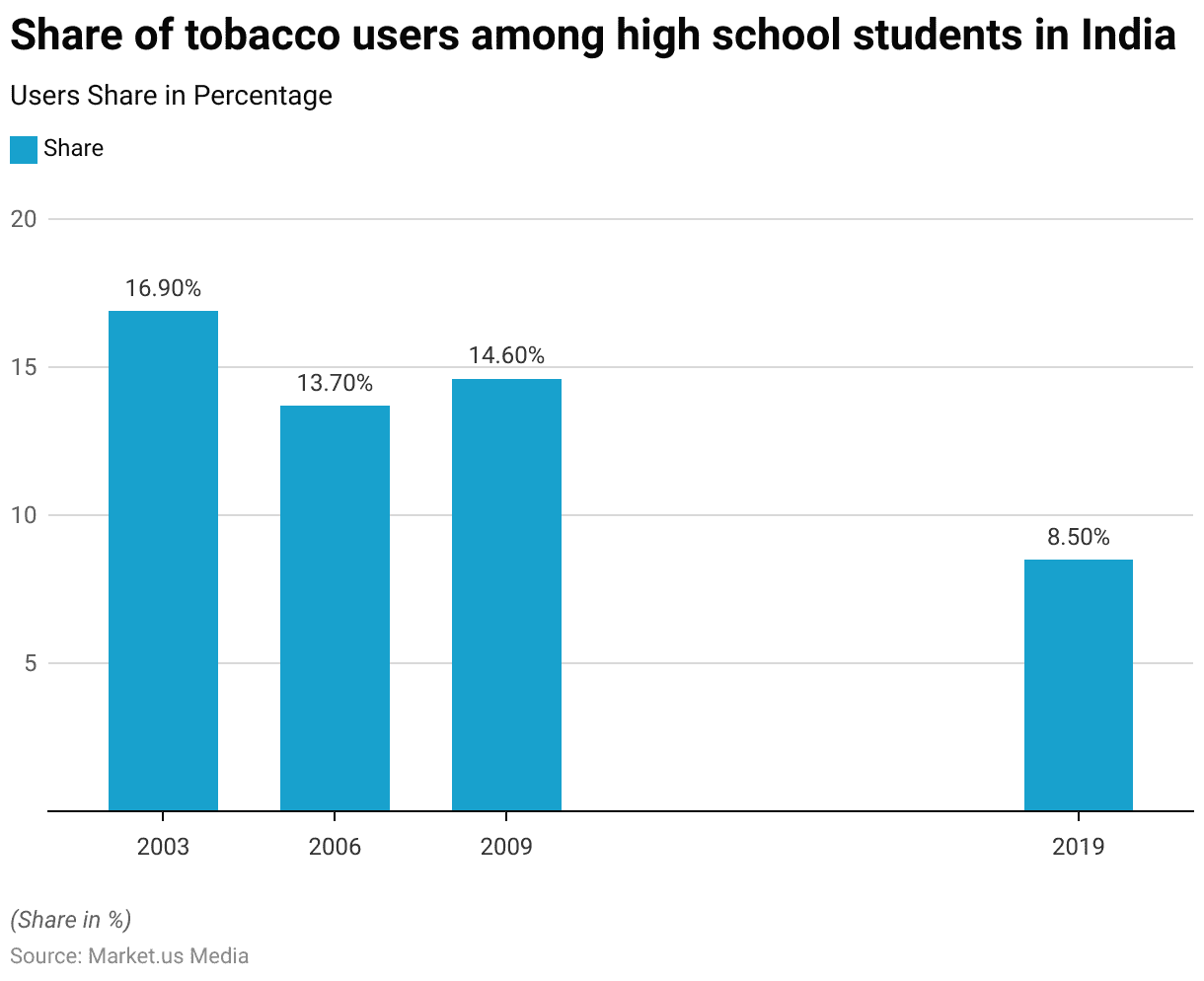
South Korea
- From 2013 to 2022, the share of middle and high school students in South Korea who smoked cigarettes experienced a gradual decline.
- In 2013, 9.7% of students reported smoking, which decreased to 9.2% in 2014.
- The downward trend continued in subsequent years, with 7.8% in 2015, 6.3% in 2016, and 6.4% in 2017.
- The percentage remained relatively stable in 2018 and 2019, both at 6.7%.
- However, there was a more significant decrease in 2020, with the smoking rate dropping to 4.4%.
- This rate remained low in 2021 and 2022, with 4.5% of students smoking during both years, indicating a consistent reduction in cigarette use among the student population over this period.
(Source: Statista)
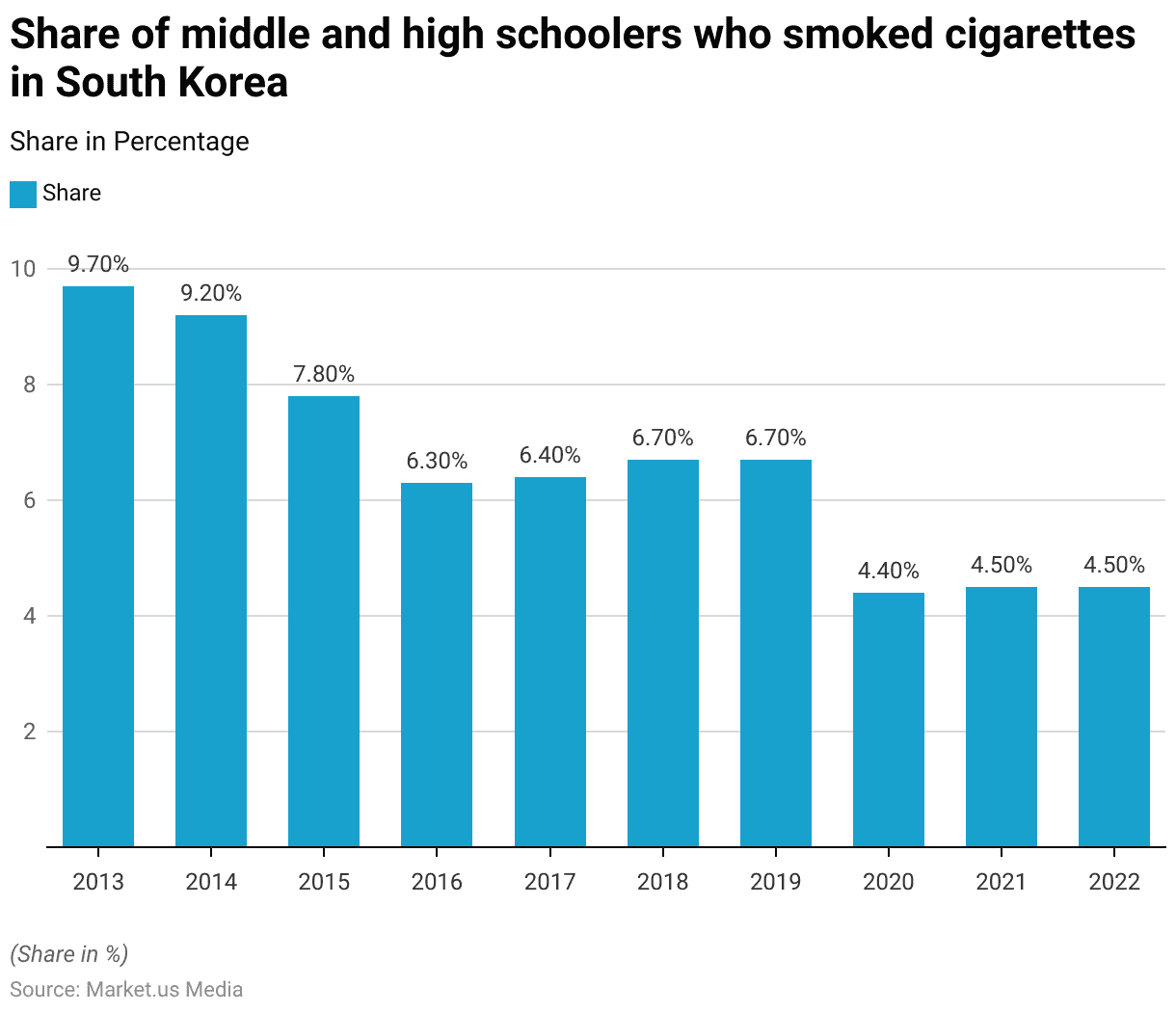
Australia
- Between 2022 and 2023, the prevalence of smoking among high school students in Australia varied by age group.
- Among students aged 12-15, 10.5% reported having ever smoked in their lifetime, while 6.5% indicated they had smoked in the past year.
- Additionally, 2.7% reported smoking in the past month, and 1.7% had smoked in the past week.
- In the older age group, students aged 16-17, the prevalence was higher, with 20.4% reporting lifetime smoking.
- Of these, 12% had smoked within the past year, 5.2% within the past month, and 2.9% within the past week.
- This data indicates a higher smoking prevalence among the older age group across all time frames.
(Source: Statista)
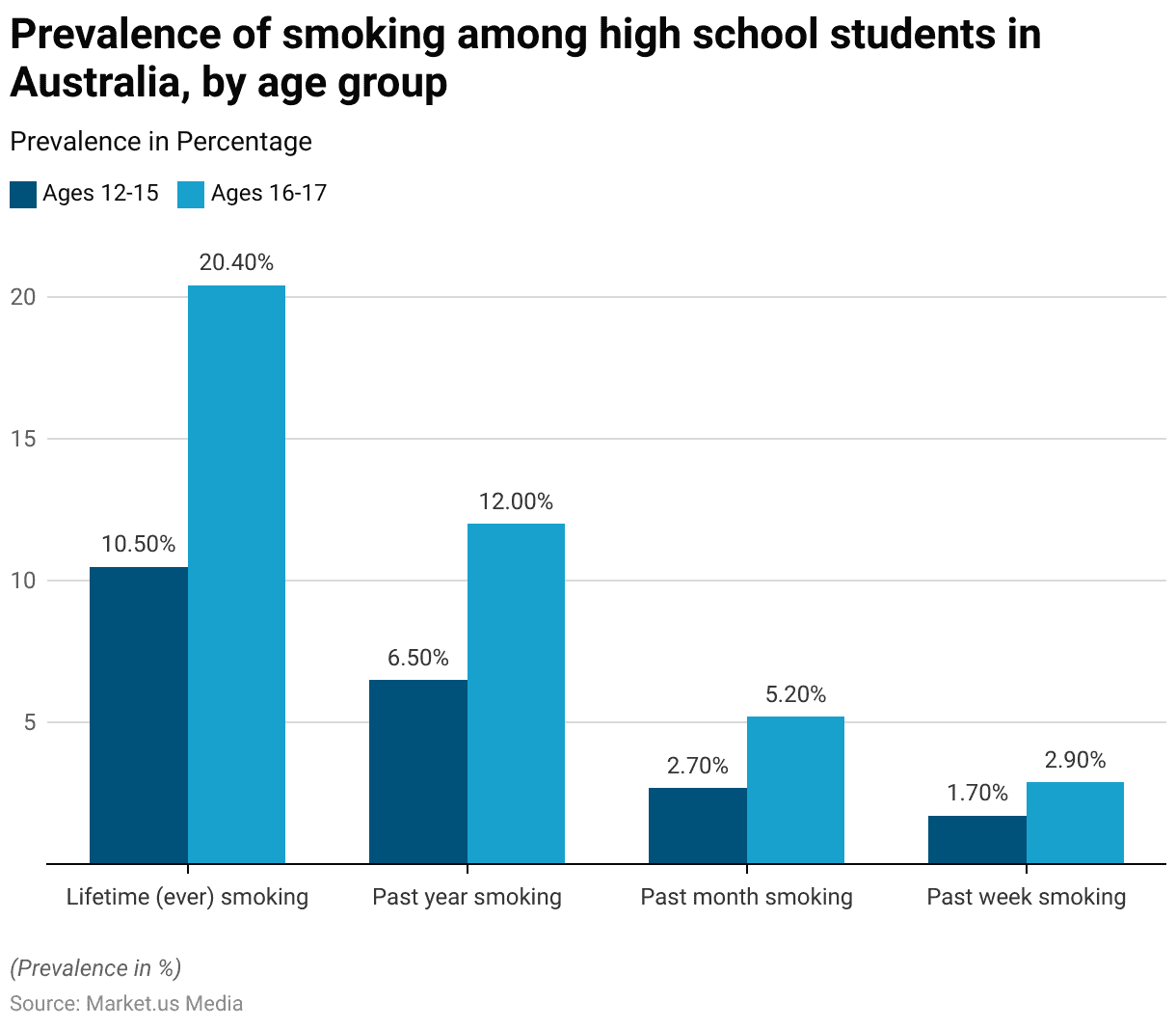
Malaysia
- In 2017, the prevalence of smoking among adolescents in Malaysia varied by school level. Among Form 1 students, 12.8% reported smoking.
- This percentage slightly decreased to 12.6% among Form 2 students.
- The prevalence increased in higher grades, with 14.3% of Form 3 students smoking, 15.3% of Form 4 students, and 14.1% of Form 5 students reporting tobacco use.
- This data indicates that smoking prevalence generally increased as students advanced to higher school levels.
(Source: Statista)

Teenage Smokers in Europe Statistics
Tobacco Smoking
- In the European Union, the prevalence of smoking among individuals aged 15-24 varied across countries and between genders.
- The overall smoking rate in the E.U. was 15.1%, with a higher rate among males (17.1%) compared to females (12.9%).
- Germany had one of the highest smoking rates, with 20.3% overall, and nearly equal smoking rates between males (20.6%) and females (19.9%).
- Hungary reported the highest smoking prevalence at 28.6%, with 32.1% of males and 25.7% of females smoking.
- In contrast, Sweden had the lowest smoking rates, with just 4.1% overall, 3.8% for males, and 4.4% for females.
- Countries like Belgium (14.9%), Bulgaria (14.3%), and France (18.6%) also exhibited relatively high smoking rates, with notable gender differences.
- Conversely, countries such as Portugal (7.9%), Finland (7.8%), and Luxembourg (7.3%) had lower smoking rates.
- Some countries, such as Spain (14.3%) and Slovenia (10.6%), had higher smoking rates among females compared to males, a trend that contrasts with the general pattern across most other nations.
- This data illustrates the variation in smoking behavior among young adults across Europe, with some countries showing high gender parity in smoking prevalence. In contrast, others present significant differences between males and females.
(Source: Eurostat)
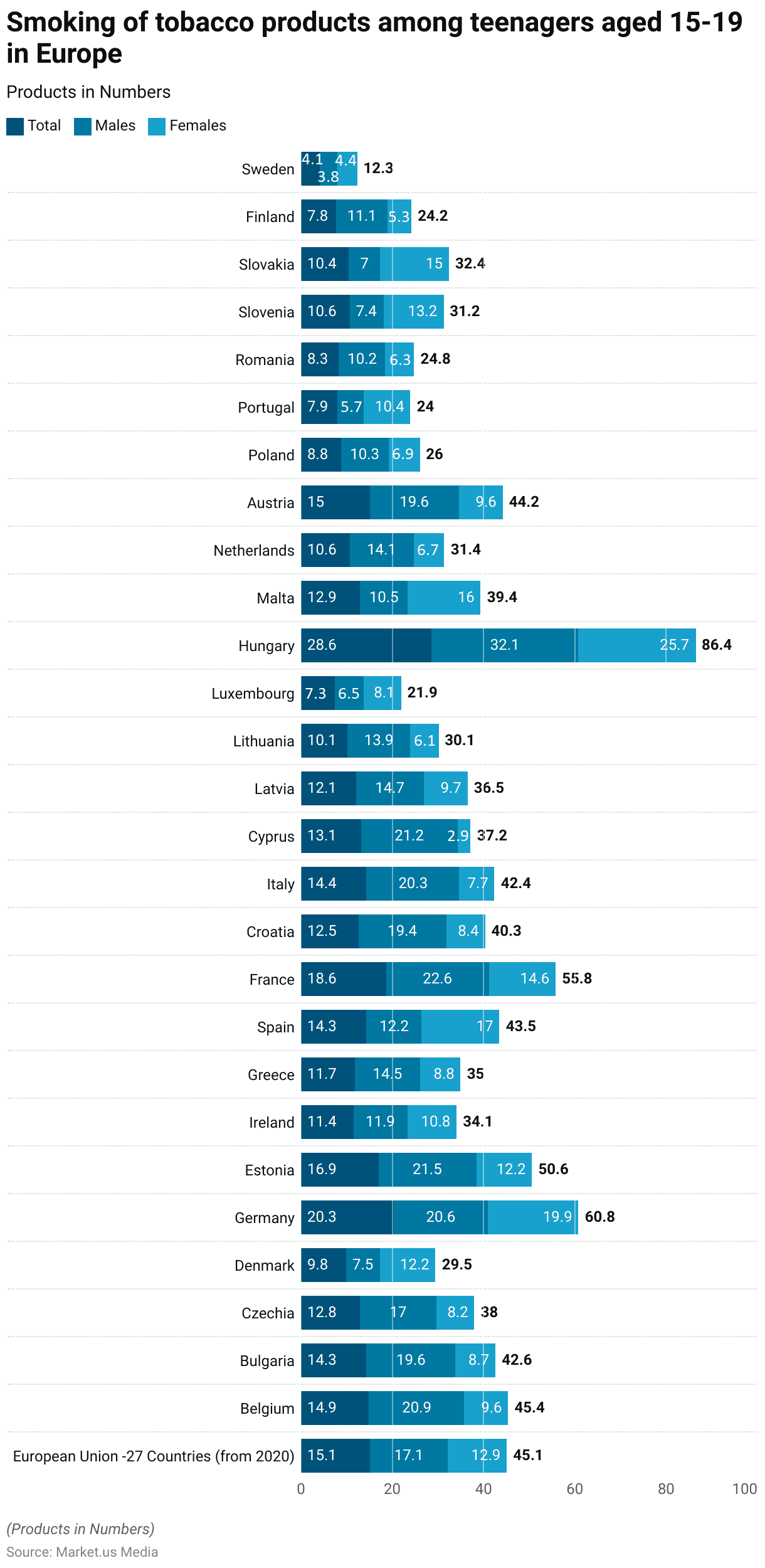
Cigarette Smoking
- The 2019 data concerning cigarette usage among students aged 16 across various European countries reveals significant variability in both 30-day and lifetime usage rates.
- Slovakia leads with a 30-day usage rate of 29% and a lifetime usage rate of 58%.
- Latvia and Italy follow closely with lifetime usage rates of 57% and 55%, respectively, and 30-day usage rates of 23% and 32%.
- Other notable figures include Czechia and Croatia, each with a 54% lifetime usage rate, though their 30-day usage rates stand at 24% and 29%, respectively.
- On the lower end of the spectrum, countries like Sweden, Norway, and Malta report relatively low lifetime usage rates at 26%, 25%, and 22% respectively, with correspondingly lower 30-day usage rates.
- Monaco and Iceland present the lowest lifetime usage rates at 15%, with a 30-day usage rate of 20% for Monaco and 5.1% for Iceland.
- This data underscores the varied landscape of cigarette experimentation and usage among teenagers across Europe.
(Source: Statista)

Teenage Smokers Frequency Statistics
- In 2021, the majority of U.S. middle and high school smokers reported using cigarettes for 1-5 days within the past 30 days.
- Among high school smokers, 66.9% fell into this category, while 68% of middle school smokers reported the same.
- A smaller proportion of students used cigarettes for 6-19 days, with 13.3% of high school students and 14.8% of middle school students reporting this level of frequency.
- Additionally, 19.9% of high school smokers and 17.2% of middle school smokers reported smoking for 20-30 days within the past month.
- This data highlights that the majority of adolescent smokers in both middle and high school tend to smoke on fewer days within a given month.
(Source: Statista)
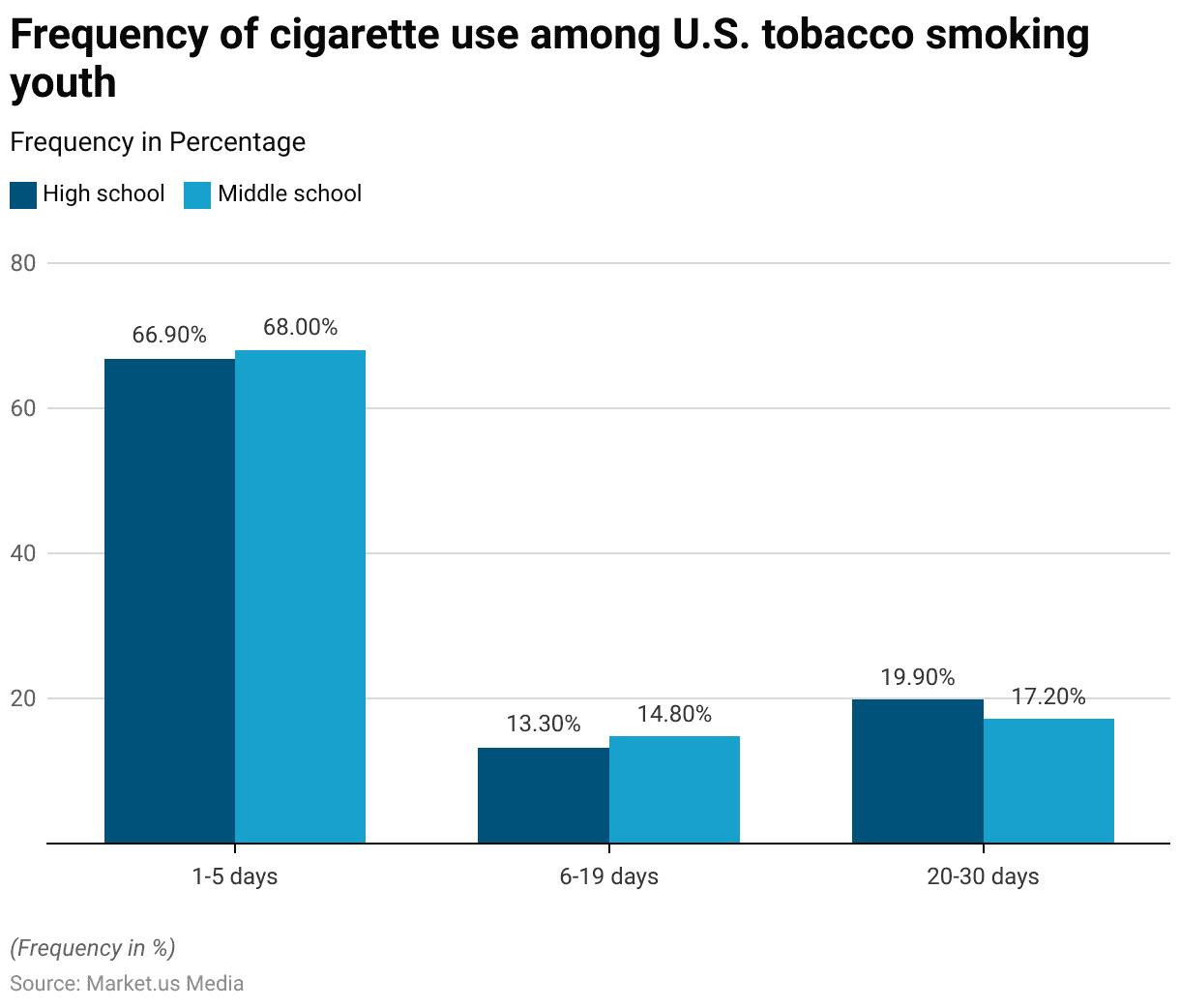
Usual Smoking Locations for High School Students
- As of 2019, high school students in India reported various usual smoking locations, with the highest share of respondents (23.5%) indicating that they smoked at home.
- Schools were the second most common smoking location, with 19.5% of students reporting smoking there.
- A significant number of students (16.7%) smoked at their friends’ houses, while 12.2% smoked in public spaces.
- Social events were a less common location, with only 8.7% of students reporting smoking in these settings.
- Additionally, 19.4% of students reported smoking in other unspecified locations.
- This data highlights the diverse environments where high school students in India engage in smoking activities.
(Source: Statista)

Acceptance of Teenage Smokers Statistics
- As of October 2019, the majority of respondents in Indonesia strongly disagreed with the notion that teenage smoking is acceptable, with percentages varying slightly by age group.
- Among the 15-19 age group, 65% strongly disagreed, while 14% disagreed.
- A similar trend was seen among respondents aged 20-24, with 66% strongly disagreeing and 12% disagreeing.
- The highest level of strong disagreement came from the 25-29 age group, where 69% strongly disagreed.
- For the older age groups (30-34, 35-39, and 40-44), around 66-67% strongly disagreed, and 12-14% disagreed.
- Only a small percentage of respondents across all age groups agreed or strongly agreed that teenage smoking is acceptable. The highest levels of agreement were seen in the 15-19 (7% strongly agreed) and 40-44 (6% agreed) age groups.
- Meanwhile, a consistent 11-13% of respondents neither agreed nor disagreed across the age groups, showing some level of neutrality on the issue.
- This data illustrates that a strong majority of Indonesians across various age groups disapproved of teenage smoking, though a small minority did express agreement.
(Source: Statista)
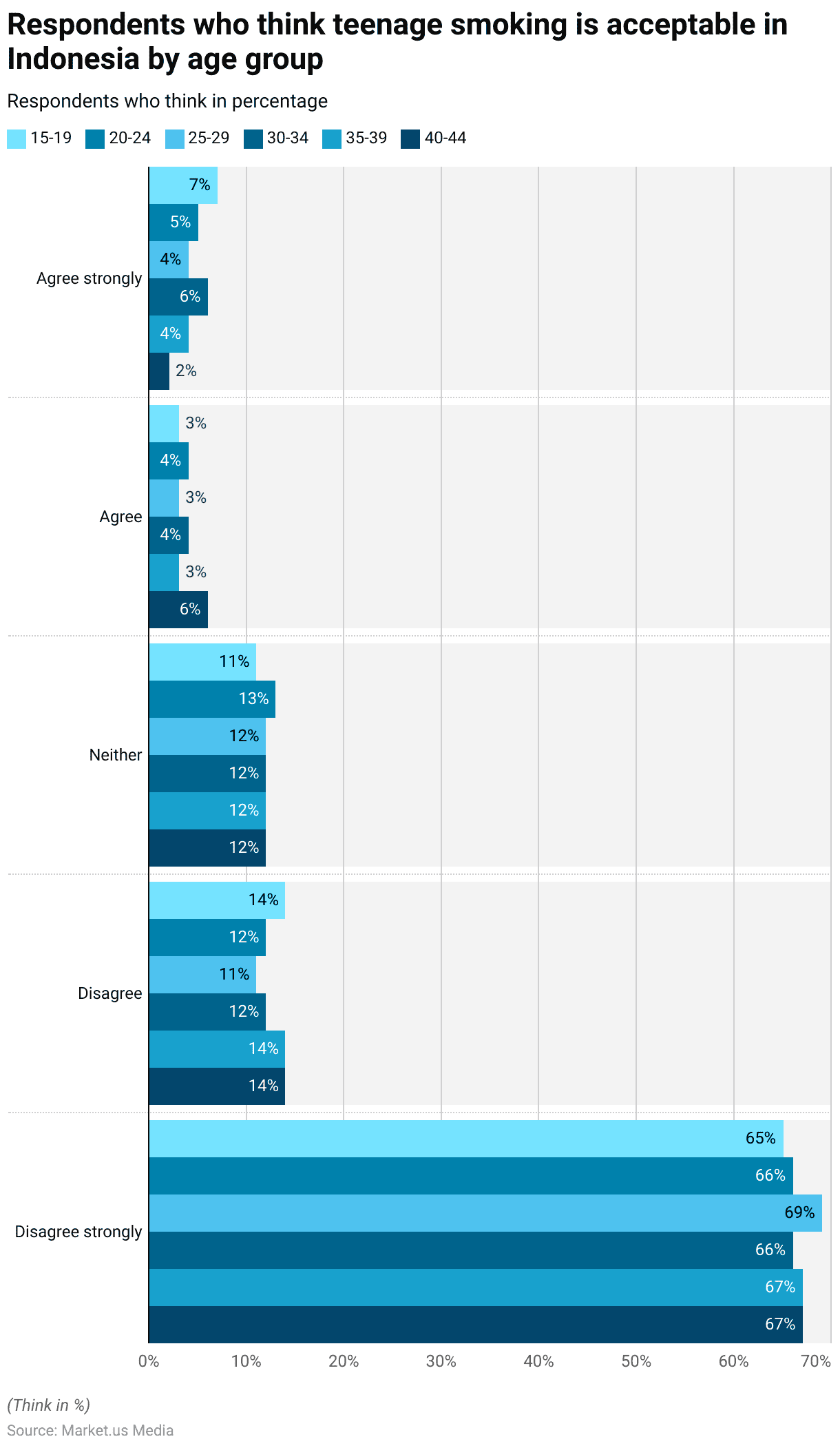
Treatments and Remedies Utilized
By Gender
- In 2022, the share of U.S. adult smokers who utilized various forms of assistance to quit smoking showed notable gender differences.
- Among men, 47.7% received health professional advice to quit, while 53.5% of women did the same, resulting in a total of 50.5%.
- Additionally, 46.4% of men and 52.2% of women received health professional assistance to quit, with an overall total of 49.2%.
- When examining the use of counseling, 6.9% of men and 7.8% of women used this method, contributing to an average of 7.3%.
- The use of medication was more prevalent, with 34.7% of men and 38.2% of women using it, bringing the total to 36.3%.
- Lastly, 36.9% of men and 40% of women reported using either counseling or medication, yielding an overall total of 38.3%.
- This data highlights the gender variations in the methods used to quit smoking, with women more likely to seek professional advice and assistance compared to men.
(Source: Statista)

By Level of Urbanisation
- In 2022, U.S. adult smokers’ use of various types of assistance to quit smoking varied based on urbanization levels.
- Among urban smokers, 49.6% received health professional advice to quit, compared to 53.9% of rural smokers.
- Additionally, 48.7% of urban smokers and 51.1% of rural smokers received health professional assistance to quit.
- The use of counseling was more common in urban areas, with 7.7% of urban smokers using it, while only 5.7% of rural smokers utilized this method.
- Medication use, however, was slightly higher among rural smokers at 38.1%, compared to 35.8% of urban smokers.
- When considering the use of either counseling or medication, 38% of urban smokers and 39.6% of rural smokers sought one of these methods to help quit smoking.
- This data indicates a slightly higher tendency for rural smokers to receive professional advice and assistance, with urban smokers showing a greater reliance on counseling.
(Source: Statista)

Initiatives to Combat Teenage Smoking
- Efforts to combat teenage smoking have seen positive results, with a notable decrease in tobacco use, particularly e-cigarettes, among high school students.
- For instance, initiatives such as the Truth Initiative’s youth-focused campaigns have effectively raised awareness about the dangers of nicotine addiction, contributing to declines in vaping rates from 27.3% to 23.2% among 12th graders in 2023.
- Programs that raise the legal age for tobacco purchases, community campaigns to limit tobacco advertising, and increased cigarette taxes have also been critical in deterring use.
- Additionally, school-based policies, support from parents, and accessible cessation programs continue to play a significant role in reducing teenage tobacco use.
- However, despite these efforts, challenges remain, as e-cigarettes, especially flavored ones, are still popular among middle schoolers.
- Therefore, ongoing public policies and educational initiatives are essential to sustain progress and address emerging trends.
(Source: American Heart Association. Truth Initiative, www.heart.org)
Government Regulations for Teenage Smoking
- Government regulations to reduce teenage smoking vary by country but generally include a combination of age restrictions, taxation, advertising bans, and public health campaigns.
- In the U.S., the FDA enforces strict laws, including a minimum purchase age of 21 for tobacco products, along with penalties for retailers that sell to minors and educational campaigns like “The Real Cost” to inform youth about the dangers of smoking.
- Many European countries follow similar guidelines, such as raising tobacco taxes and banning advertising targeting youth.
- The U.K., for instance, prohibits tobacco sales to anyone under 18 and requires plain packaging to reduce product appeal.
- Globally, the WHO Framework Convention on Tobacco Control (FCTC) provides a foundation for countries to regulate tobacco use, with countries like Australia leading by adopting stringent plain packaging laws and banning all forms of tobacco marketing.
- These policies collectively aim to reduce smoking rates among teens, addressing both access and exposure to tobacco products.
(Source: FDA.gov)
Recent Developments
New Campaigns and Initiatives:
- FDA expands “The Real Cost” campaign: In 2023, the U.S. Food and Drug Administration (FDA) expanded its “The Real Cost” campaign to specifically target teenagers using e-cigarettes and other tobacco products. This campaign, with a budget of $60 million, aims to educate young people about the health risks associated with smoking and vaping.
- UK government launches youth anti-smoking initiative: In late 2023, the UK government launched a national campaign targeting teenage smokers, allocating £30 million to provide education in schools and online resources. The goal is to reduce the teenage smoking rate by 50% by 2030.
Partnerships and Collaborations:
- Truth Initiative partners with TikTok: In 2024, the Truth Initiative, a leading anti-smoking organization, partnered with TikTok to create viral content aimed at discouraging teenage smoking and vaping. This initiative, which reaches over 1 million views per week, leverages popular influencers to engage younger audiences.
- WHO collaborates with the CDC for global youth tobacco surveys: In 2023, the World Health Organization (WHO) partnered with the Centers for Disease Control and Prevention (CDC) to conduct a series of global youth tobacco surveys, gathering data on smoking rates among teenagers in over 30 countries. The aim is to identify trends and develop policies to reduce teenage smoking.
Funding for Research and Prevention:
- NIH awards $50 million for smoking prevention research: In 2023, the National Institutes of Health (NIH) awarded $50 million in grants for research on preventing teenage smoking. The research focuses on understanding the influence of social media, peer pressure, and mental health on teenage smoking habits.
- European Union allocates €100 million for anti-smoking programs: In 2024, the European Union allocated €100 million to fund new initiatives aimed at reducing smoking among teenagers in Europe. These programs include public health campaigns, smoking cessation resources, and school-based education.
Technological Advancements:
- Mobile apps for smoking cessation: Mobile apps targeting teenage smokers are becoming more prevalent, offering tools to help young people quit smoking. By 2025, over 30% of teenage smoking cessation programs are expected to use digital platforms and mobile apps, which provide personalized plans and peer support.
- AI-driven research into teen smoking behavior: AI is being increasingly used to analyze patterns and behaviors in teenage smoking. By 2026, AI-powered tools are projected to account for 20% of new initiatives aimed at understanding the social and psychological drivers of teenage smoking.
Market Dynamics and Statistics:
- Decline in teenage smoking rates: The number of teenage smokers has been steadily declining in many countries. In the U.S., the percentage of high school students who smoke dropped to 4.6% in 2023, a significant decrease from previous decades. This decline is largely attributed to anti-smoking campaigns and increased awareness of the risks associated with smoking.
- Rise in teenage vaping: Despite the decline in traditional cigarette use, vaping remains a concern. In 2023, 16% of teenagers in the U.S. reported using e-cigarettes, highlighting the shift from traditional smoking to vaping among youth. Anti-vaping campaigns are becoming a crucial part of teenage smoking prevention efforts.
Conclusion
Teenage Smokers Statistics – Teenage smoking remains a critical public health issue, influenced by factors such as peer pressure, accessibility, and targeted marketing.
Although smoking rates have declined due to regulations and health campaigns, the rise of e-cigarettes and vaping presents new challenges.
Moreover, effective prevention requires a comprehensive approach, including stricter marketing controls, education on health risks, stronger parental and community involvement, and better enforcement of age-related sales laws to reduce smoking rates and protect adolescent health.
FAQs
Teenagers often begin smoking due to peer pressure, curiosity, stress, and exposure to tobacco marketing. Easy access to cigarettes and a desire to appear more independent or mature also contribute.
Teenage smoking increases the risk of respiratory problems, heart disease, addiction to nicotine, and long-term issues like cancer. Early initiation can lead to lifelong smoking habits and a higher likelihood of chronic illnesses.
Yes, teenage smoking rates have generally declined in many countries due to stricter regulations, public health campaigns, and increased awareness of health risks. However, the popularity of e-cigarettes and vaping has become a new concern.
Parents can help by fostering open communication, educating teens about the risks of smoking and vaping, setting clear expectations, and being role models by not smoking themselves. Monitoring peer influence and providing support during stressful times can also be effective.
Yes, most countries have laws that prohibit the sale of tobacco and nicotine products to minors, often with age restrictions set at 18 or 21. Enforcement of these laws is critical to reducing teenage smoking.
Quitting smoking is difficult at any age, but teenagers may face unique challenges due to peer pressure and nicotine addiction. Support from parents, counseling, and smoking cessation programs can improve the chances of success.
Discuss your needs with our analyst
Please share your requirements with more details so our analyst can check if they can solve your problem(s)



